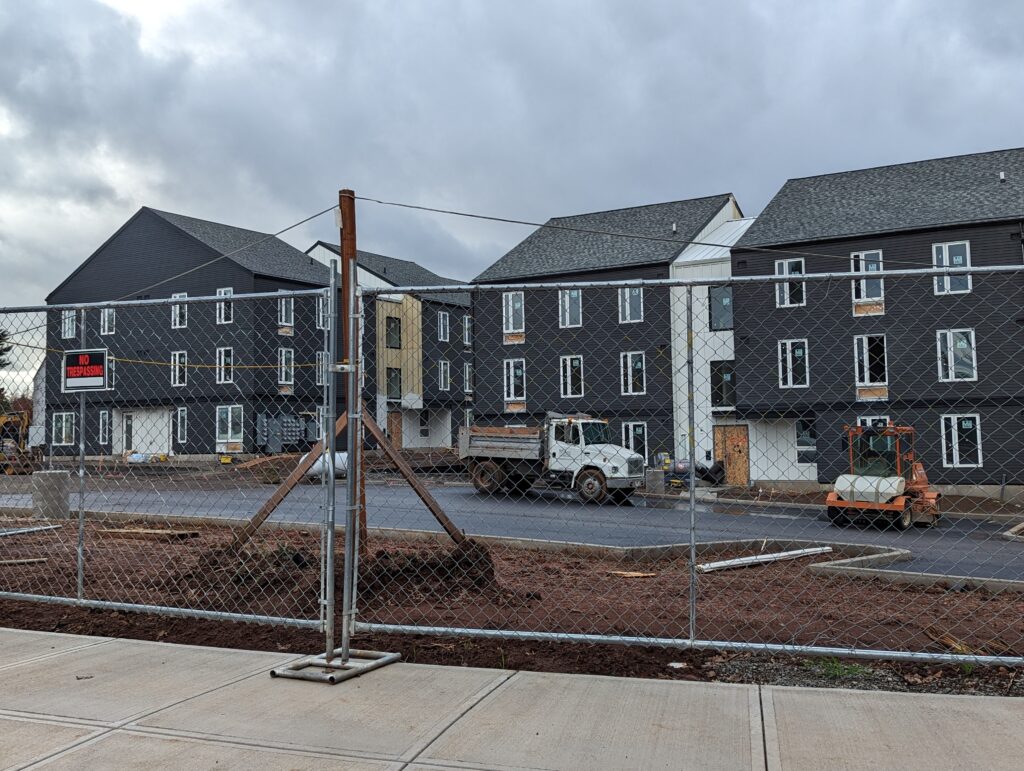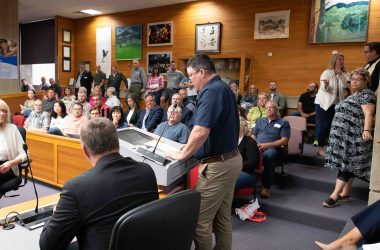By the end of the year, hundreds of wildfire survivors, agricultural workers and low-income Salemites will have a new home.
Mahonia Crossing, a private housing development in south Salem, is wrapping up construction and leasing apartments.
It’s the largest affordable housing development in recent times, the latest for a city that has seen a huge boom in such construction over the past five years.
The path to completion is complex, involving a variety of money sources, the right blend of rents and a trip through a cumbersome permitting system.
Projects like Mahonia Crossing can take years, and demand exceeds the available government grants, loans and other subsidies that support development.
What is affordable housing?
The concept of affordable housing is simple: homes where rent is low enough that a family can still afford food, gas, medical bills and other necessities.
Housing advocates and government agencies generally agree that a family’s housing should cost no more than one-third of their income.
That doesn’t require government involvement or subsidies. It could mean living in a house with the mortgage paid off, or renting from a mom-and-pop landlord who keeps prices low.
In practice, government agencies have their own definitions for affordable housing that depend on the tax breaks or subsidies given to a development.
Those putting up affordable housing with public help contend with the same factors that slow other projects: rising costs for materials, supply chain delays and lags in getting permits.
On top of those, affordable housing projects face additional challenges. Successfully obtaining any of a variety of state grants or special loans can take months.
“It takes a lot of time to pull all that money together,” said Thomas Eldridge, development manager for Community Development Partners. The Portland-based firm is the developer of Mahonia Crossing and other affordable housing projects around western Oregon and southern California.
Government involvement in housing is intended to keep rents lower than they’d be otherwise.
It can come from grants, tax credits, government-backed loans and other mechanisms.
In exchange for taking state money, developers agree to keep rents set below certain levels.
Once a complex is built, it may be exempt from property taxes.
Other than that exemption, there are no ongoing government subsidies for the property. The rents tenants pay cover the cost of operating the housing, like maintenance and repairs.
To see how all these factors come together, consider Mahonia Crossing.
What is Mahonia Crossing?
Mahonia Crossing is a 313-unit affordable housing development in Salem’s South Gateway neighborhood, 5120 Salal St. S.E. It has one-, two- and three-bedroom apartments.
The complex has several buildings open and leasing, and others under construction. It’s intended to be a mixed-generation development, allowing housing for seniors alongside families with kids.
Some units are reserved for wildfire survivors and agricultural workers. Under an agreement with the state, the property will remain affordable for 30 years.
Who owns the development?
Community Development Partners, a Portland development company.
The company expects to profit off the development, Eldridge said, but returns are lower than for market-rate housing. Typically, private companies that develop affordable housing have a community-minded mission.
“For the amount of housing that needs to be built, if you want to incentivize good developers to develop homes at the rate we need them, I think it’s only fair and reasonable that there is some sort of incentive there,” he said.
When did the project launch?
Developers began working on Mahonia Crossing in 2021, applying for state money and securing other funding.
The land was owned by John Miller, a longtime Salem developer. Miller is president of Wildwood | Mahonia and has developed much of the surrounding land over the past few decades.
He’d long envisioned an affordable or senior housing project on the land, but realized he didn’t have the expertise to turn the 15-acre site into what he envisioned.
“I could have sold the property at a higher price to other folks but I knew these guys were going to do a great job,” he said of Community Development Partners.
Construction began in 2022 and is ongoing. Two buildings are complete and leased. A building for seniors is scheduled for completion in April, and a community building in May. The entire complex should be finished and leasing by the end of 2024.
How much did it cost?
The full development cost $114 million. With 313 units, that’s a cost of $364,000 per apartment.
How was it funded?
Grants from the state of Oregon are the largest source of funding, with loans, private funding and other sources making up the rest.
The state gave developers almost $42 million in grants through Oregon’s Local Innovation and Fast Track program. LIFT is a state program for encouraging affordable housing. Over half the state grant money was earmarked for projects housing wildfire survivors.
Another $4.6 million from the state helped cover rising construction costs.

Developers got another $38 million borrowed through state-backed bonds. That loan has to be repaid, but carries a lower interest rate than traditional financing.
Government tax credits provided another $6.1 million. The state issues the developer credits which can then be sold to private investors.
Overall, Eldridge said the complex is funded 40% by government grants, 26% by loans, 24% by private funding and 10% by other sources.
How much is rent?
Apartments are reserved for people making less than Salem’s median income. The income limits and rents vary depending on which building people live in.
For most of the complex, income is capped at 60% of Marion County’s median. That means a couple can make at most $40,200 per year, and a family of four $50,220.
Rents start at $910 monthly for a one-bedroom and $1,060 for a two-bedroom apartment.
Some of the apartments for very low-income households are leased to people referred by the Salem Housing Authority and come with a housing voucher, a federal rent subsidy. That means occupants would pay no more than 30% of their income in rent.
Why does affordable housing cost so much to develop?
Building costs for every type of development have skyrocketed over the past two years because of the rising prices of materials and labor.
But affordable housing generally costs more per unit than market-rate housing to build.
Some of the difference is because of the additional regulations that come with affordable housing.
Developers must pay prevailing wages for labor. For Mahonia Crossing, Eldridge said that increased construction costs by about 10%.
Financing projects can be more challenging, particularly attracting private investment.
“Most affordable housing developers, nonprofits and rural housing developers in particular, have to borrow at higher rates, are required to provide financial guarantees, and have to have several funding stacks. Market rate housing developers will likely have a good balance sheet to borrow from only one lender,” said Delia Hernandez, spokeswoman for Oregon Housing and Community Services. That’s the state agency that oversees housing policy.

Affordable complexes are also designed to last longer, Hernandez said. Developers typically must keep apartments affordable for a period of 30 to 60 years under agreements to receive government money.
“The physical building needs to last a good part of these years without major rehab and refinancing, and the developers need to secure lasting materials. Ensuring the public purpose and interest of the state is protected, the financial structure involves complex and expensive legal and accounting reviews that market rate housing doesn’t have,” Hernandez said.
Developers also often include community buildings or other amenities. Those have to be paid upfront.
That’s the case at Mahonia Crossing, where a community center that will be used by residents and the wider neighborhood is under construction.
Eldridge said Mahonia Crossing’s cost is also due to significant improvements developers had to make to neighboring Battle Creek Road, including sidewalks, and managing stormwater runoff for the large property.
How do people get an apartment?
People can apply on the Mahonia Crossing website. There’s more detail about requirements and income restrictions there.
Currently, 36 apartments are finished, with more to be completed in the coming months. There are 272 households on the waitlist.
Correction: This article originally listed the annual income limits for Mahonia Crossing as monthly income limits. Salem Reporter apologizes for the error.
Contact reporter Rachel Alexander: [email protected] or 503-575-1241.
SUPPORT OUR WORK – We depend on subscribers for resources to report on Salem with care and depth, fairness and accuracy. Subscribe today to get our daily newsletters and more. Click I want to subscribe!

Rachel Alexander is Salem Reporter’s managing editor. She joined Salem Reporter when it was founded in 2018 and covers city news, education, nonprofits and a little bit of everything else. She’s been a journalist in Oregon and Washington for a decade. Outside of work, she’s a skater and board member with Salem’s Cherry City Roller Derby and can often be found with her nose buried in a book.









